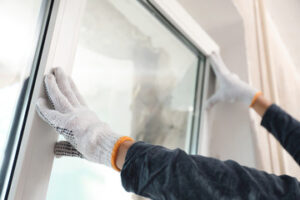Window replacement can be a major investment, but if your windows have irreparable damage or pose safety concerns, it may be time to replace them. Easton Replacement Windows can boost curb appeal, increase energy efficiency and help you save money.

Understanding the different parts of a replacement window can help homeowners make more informed decisions. Advancements in window frame technology have allowed newer windows to withstand natural expansion and contraction, maintain a tight seal and require less maintenance.
When you replace old windows with new, energy efficient ones, you are doing more than just making a cosmetic improvement to your home. You’re also reducing the amount of energy your heating and cooling systems consume. This reduction results in a noticeable decrease in your monthly utility bills and, over time, can even offset the cost of the replacement windows themselves.
Modern windows have been designed to minimize heat transfer, which is one of the most significant reasons for their energy efficiency. They help to keep the warm air in during chilly winters and the hot air out in scorching summers, thereby alleviating some of the strain on your HVAC system.
You can make your replacement windows even more energy efficient by selecting a frame material that has been designed to reflect rather than absorb the heat that passes through it. Fiberglass frames, for example, are excellent at reflecting heat and moisture vapor, which can significantly reduce your energy costs.
In addition, you can add Low-E glass to your window to block more UV rays and infrared heat. By blocking these harmful rays, you can dramatically decrease the sun’s impact on your furniture and floor coverings and extend their lifespan.
When shopping for new windows, be sure to compare their energy performance ratings using the information found on their ENERGY STAR or NFRC labels. It’s also important to select a reputable window company that has great reviews, longevity in your area, and high-quality products and processes.
The energy efficiency of your replacement windows will have a positive impact on your home’s value, too. Remodeling Magazine estimates that homeowners can recoup about 69% of the cost of their replacement windows when they sell their homes.
If you’re ready to start saving on your energy costs, contact us today to learn more about our extensive selection of energy-efficient replacement windows. We’ll work with you to select the perfect options that meet your unique needs and style preferences. Our experts are standing by to answer your questions and assist you in choosing the perfect new windows for your home.
Aesthetics
Investing in new replacement windows isn’t only about improving your home’s functionality and energy efficiency; it’s also an opportunity to improve the overall aesthetic of your living space. Whether you’re looking to boost your home’s curb appeal or create a harmonious flow between your rooms, you can easily achieve your design goals with the help of modern window styles. From frames and grilles to color, style, and trim, you can choose from a wide array of customization options that will allow you to transform your home’s interior and exterior design.
When choosing a style for your replacement windows, consider the existing architectural design of your house and choose a window design that complements it. For instance, double hung windows blend well with both traditional and contemporary homes. They are also taller than they are wide, which makes them a great choice for rooms that need extra natural light. A casement window is another option that can add a touch of elegance to any room while providing ventilation and a clear view of your yard and surroundings.
The type of glass you select for your replacement windows can also have a significant impact on the visual appeal of your home. While clear glass is a classic choice that provides unobstructed views, other options like frosted and tinted windows offer varying degrees of privacy while enhancing your home’s interior design.
Once you’ve selected a style and frame material, you can begin thinking about the finishing touches for your new windows. You can choose from a variety of colors and metals for your window hardware, including stainless steel, bronze, and aluminum. Depending on your tastes, you may prefer a more minimalist design with just a hint of accent color or something that is more prominent and eye-catching.
Regardless of your style preferences, you can rest assured that your new replacement windows will enhance the look of your home and boost its resale value. With the right selection, your new windows will become focal points of your living spaces and create a lasting impression on any visitors to your home.
Noise Reduction
Whether it’s from the neighbors, garbage trucks, or the barking dog next door, unwanted noise can disturb your peace and make it difficult to rest and recharge. Replacement windows can help reduce the noise in your home, making it a more relaxing sanctuary.
Many modern replacement windows come with features that reduce unwanted sound. They may have an insulated frame, double-pane glass or a laminated coating between the glass panes. Some are even available with a Low-E (low-emissivity) coating that improves energy efficiency and also helps reduce outside noises.
To maximize the noise reduction of your replacement windows, be sure to select a model that has a high STC rating, which measures how much sound is blocked. The STC of two-by-four walls is about 20; the STC of dual-pane windows with Noise Reduction Glass is 33—which means that these windows offer protection from exterior noises almost as good as a thick, insulated wall.
The type of window you choose is also important for sound reduction. Most homeowners can improve the noise reduction of their existing single-pane windows by upgrading to a double-pane window. This will significantly decrease the amount of noise that enters their homes.
In order to reduce the noise in their home, some homeowners prefer to install triple-pane windows, which provide an even greater degree of soundproofing. While these windows are typically more expensive than double-pane models, they can be an effective solution for some homeowners.
The proper installation of your new replacement windows is also essential for maximizing their sound-reducing abilities. This includes using accurate measurements and cleaning the area around the window before your contractor starts the installation process. It is best to hire a professional who is experienced with installing replacement windows and knows how to properly measure and clean the window opening.
Replacement windows can be a smart upgrade for any homeowner looking to add value to their home and improve the comfort of their living space. They are usually more affordable than new construction windows and can be installed in place of outdated, old-fashioned frames without a major renovation. In fact, most replacement windows can be installed from inside the home, which can save on labor costs and minimizes damage to the existing frame and trim.
Maintenance
The beauty and functionality of replacement windows can only be fully realized when homeowners are proactive about their maintenance. A routine of cleaning and a periodic inspection of hardware, caulking, and seals will help extend the life of your new windows. This prevents issues that can impact energy efficiency and the comfort of your home and may prevent costly repairs or replacements down the road.
New windows are more efficient than old ones because they have better insulating qualities and coatings that block out excessive UV rays. They will also have better water resistance that protects your interior from moisture and mold.
Replacement windows come in a variety of frames and styles to suit your home’s style and architecture. Some have a wood exterior with vinyl or aluminum-clad siding for protection and durability. Other replacement windows have a fiberglass or foam insulation core for superior energy efficiency. The frame is then finished with either a natural finish or paint for a beautiful aesthetic.
To ensure that your replacement window is the right size for your existing window opening, your contractor will take accurate measurements of your current window at three different points and then use the smallest measurement to guarantee a precise fit. Then the installation process can begin. The first step is to remove any blinds or window coverings that are in the area. Next, the contractors will clean the entire window area and frame to ensure that there is an even surface for the new installation.
Full-frame replacement windows are installed by removing the trim and casing to access the existing window frame. They are then installed into the window opening to create a seamless look that matches the existing frame and other home features. Insert replacement windows are installed by sliding into the existing window frame without removing the trim or casing. This method is often used in older homes that are seeking to preserve the original frame and style of the building.
Your windows should open and close easily, lock securely, and provide a good view. If they are difficult to open or have to be forced to shut, this is a sign of deteriorating seals and frames that will allow drafts and moisture into your home. Moldy windows should be replaced as soon as possible to avoid health and structural problems.

